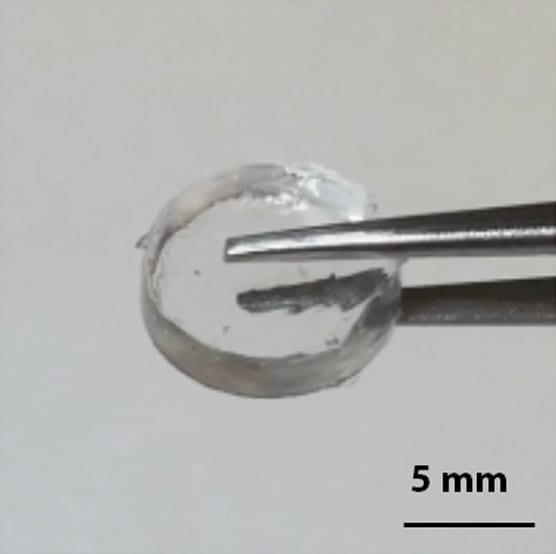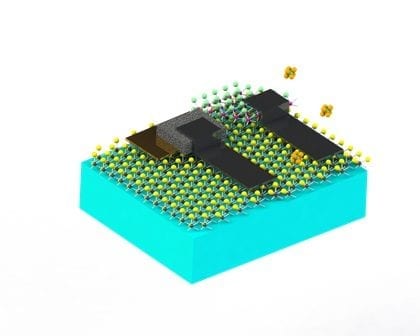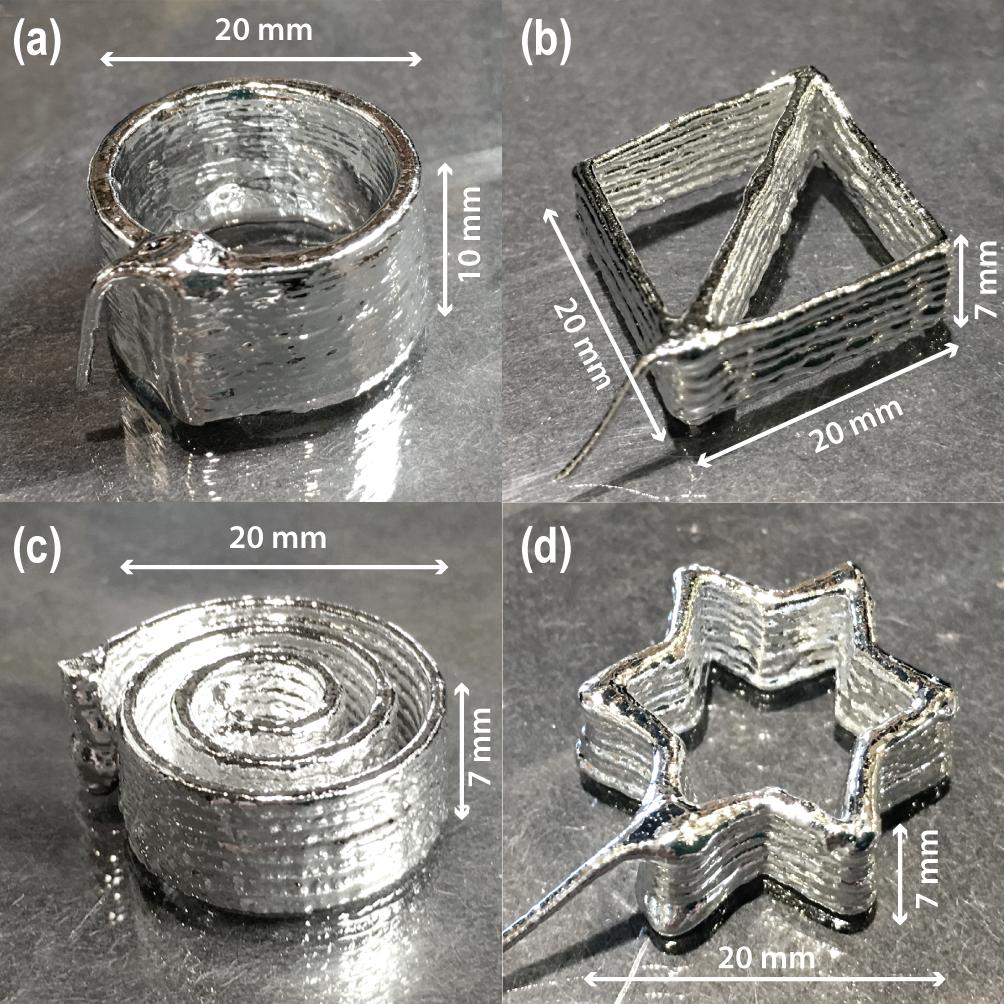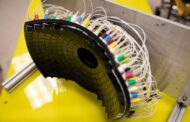
via medicalxpress.com
A new study by Dana-Farber Cancer Institute scientists suggests it may be possible to prevent tumors from recurring and to eradicate metastatic growths by implanting a gel containing immunotherapy during surgical removal of a tumor.
In the study, published online today by Science Translational Medicine, researchers removed breast tumors from mice and placed biodegradable gels containing an immune-stimulating drug in the resulting empty space. The gels released the drug, which switches on a key type of immune cell, over an extended period of time. When researchers examined the animals over the next several months, they found that this approach cured a much higher proportion of mice than delivery of the drug by other techniques. Not only did the original tumors not recur in the breast, but metastatic tumors in the lungs – far away from the site of drug delivery – were eliminated as well.
The researchers say the findings, which were duplicated in mice with lung cancer and melanoma, hold immense promise for overcoming two of the greatest obstacles to curing cancer: 1) the tendency of the disease to recur in patients who have undergone surgery to remove solid tumors; and 2) the difficulty in eradicating distant metastases.
“Surgery is the main treatment option for patients with most solid tumors, but recurrence and metastasis remain significant problems,” says study senior author Michael Goldberg, PhD, assistant professor at Dana-Farber and Harvard Medical School. “Even when an entire tumor has been removed, it is common for a small number of tumor cells to remain behind. Indeed, while half of all cancer patients undergo surgery aiming to cure the disease, 40 percent of such patients experience a recurrence of the disease within five years. Furthermore, it has been shown that the body’s natural process of healing the wound created by surgery can actually spur these residual cancer cells to metastasize to distant parts of the body and form new growths.
“The long-lasting anti-cancer effects produced by immunotherapy can be very powerful, but the percentage of patients who benefit from such drugs has been somewhat modest to date. In this study, we sought to determine whether administering immune-stimulating drugs at the place and the right time – at the site of tumor removal, before the surgical wound has been closed – could enhance the results of cancer immunotherapy.”
For this approach to work, the researchers reasoned that they would need to alter the immunological conditions inside the surgical wound. When a tumor is removed, both cancer cells and neighboring cells – including immune cells and connective tissue – are removed as well. This so-called tumor microenvironment often contains cells, proteins, and other substances that deter the immune system from attacking the tumor. The removal of these components might be expected to unleash an assault by the immune system on cancer cells left after surgery. However, surgery also removes cancer-fighting immune cells and proteins that are critical for the immune system attack. Moreover, in the aftermath of surgery, the immune system concentrates most of its efforts on healing the surgical wound, lowering its guard against cancer cells. It’s this “immunosuppressive” microenvironment that gives the remaining tumor cells license to metastasize and flourish in other parts of the body.
The goal of the new approach is to convert that immunosuppressive environment into an “immunostimulatory” one, Goldberg says – a condition in which the immune system is primed for an offensive against cancer cells.
In the study, the researchers loaded a hydrogel – a half-inch disc made of a biodegradable sugar naturally found in the human body – with drugs that activate dendritic cells. Dendritic cells are part of the innate immune system – the body’s first responders to foreign intruders or diseased cells. The hydrogel, placed in the spot where the tumor was removed, releases the drug over an extended period of time, lengthening the window of effectiveness. When the dendritic cells are activated, they train T cells – their allies in the adaptive arm of the immune system – to attack cancer cells anywhere in the body, whether at the site of the original tumor or distant metastases.
The decision to implant the hydrogel at the time of surgery was based on several considerations. “We reasoned that it would be easier to eliminate a small number of residual cancer cells by creating an immunostimulatory environment than it would be to treat an intact primary tumor, which has many means of evading an immune system attack,” Goldberg notes. Moreover, administering immunotherapy prior to surgery could potentially produce immune-related side effects that could require delaying surgery. And administering the therapy after surgery and after the wound has had a chance to heal could be less effective, a previous study suggests.
The researchers confirmed that the approach succeeded in flipping the post-surgical context of the wound area from an immunosuppressive state to an immunostimulatory one. Among the treated mice, cure rates were much higher than in animals that received free drug that had not been loaded into the hydrogel, whether the drug was injected intravenously or even directly into the tumor. The animals treated with the new approach didn’t appear to suffer any adverse effects from the therapy, Goldberg remarks. His group assessed the animals for changes in body weight as well as potential toxicity to the liver, kidney, and blood cells – none of which was observed.
The benefits of this approach to treatment appear to be enduring. Three months after the mice underwent the treatment, they didn’t have a recurrence. When researchers injected fresh breast cancer cells in the side opposite the original tumor site, the disease didn’t recur in any of the mice, as the cancer was rejected by the immune system’s memory.
“This technique works particularly well with immunotherapies that are otherwise typically injected into tumors that are readily accessible, which represents a minority of solid tumors,” Goldberg relates. “The ability to address any solid tumors that can be surgically removed greatly increases the number of patients who might benefit from such potent immune-stimulating agents, which can be toxic when administered throughout the body. “This approach has the potential to deliver immunotherapy in a manner that focuses the therapy at the site of interest during a critical time window,” he continues. “We are extremely encouraged by the results of this study and hope that this technology will be adapted for patients for testing in clinical trials in the not-too-distant future.”
The Latest on: Immunotherapy
[google_news title=”” keyword=”immunotherapy ” num_posts=”10″ blurb_length=”0″ show_thumb=”left”]
via Google News
The Latest on: Immunotherapy
- Ketone supplement boosts efficacy of prostate cancer immunotherapyon April 26, 2024 at 7:51 pm
and Mary Jo Boler Collegiate Associate Professor in the Department of Biological Sciences, and collaborators tackled a problem oncologists have battled: Prostate cancer is resistant to a type of ...
- Can cancer vaccine with immunotherapy shrink liver tumor?on April 26, 2024 at 7:30 pm
According to a study published in the journal Nature Medicine, people with Hepatocellular Carcinoma treated with immunotherapy and a personalized anti-tumor vaccine were twice as likely to experience ...
- Immunotherapy and hay feveron April 26, 2024 at 2:09 am
Hope is at hand, however, in the form of immunotherapy. The most acute hay fever sufferers are sometimes referred for the treatment, and now new research "highlighting its effectiveness" may lead to ...
- Side effects of immunotherapy for cancer treatmenton April 25, 2024 at 5:31 pm
Trenton Stewart of Davenport is charged with forging checks stolen during break-in. Moline City Council endorsed the $6.8 million redevelopment proposal to convert the old JCPenny building to ...
- Vitamin D may balance gut microbiome to give cancer immunotherapy a booston April 25, 2024 at 12:30 pm
A new study in mice found that dietary vitamin D plays a role in balancing the gut microbiome and improving the way cancer immunotherapy works to fight tumors.
- Immunotherapy Combination Approved for Non-Muscle Invasive Bladder Canceron April 24, 2024 at 2:43 am
FDA approves immunotherapy drug combo for non-muscle invasive bladder cancer after UCLA-led research shows improved outcomes for patients.
- FDA approves immunotherapy drug combo for non-muscle invasive bladder canceron April 23, 2024 at 10:44 am
The U.S. Food and Drug Administration (FDA) has approved the immunotherapy-boosting drug N-803, which is marketed under the brand name Anktiva, to be used in combination with the immunotherapy ...
- AI could predict whether cancer treatments will work, experts say: ‘Exciting time in medicine'on April 23, 2024 at 3:00 am
A chemotherapy alternative called immunotherapy is showing promise in treating cancer — and a new artificial intelligence tool could help ensure that patients have the best possible experience.
- Scientists making progress in less toxic cancer treatment called immunotherapyon April 22, 2024 at 3:04 pm
Scientists are making progress in using less toxic immunotherapy instead of traditional chemotherapy to fight cancer.
via Bing News







